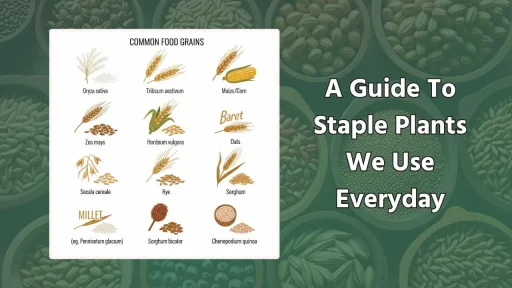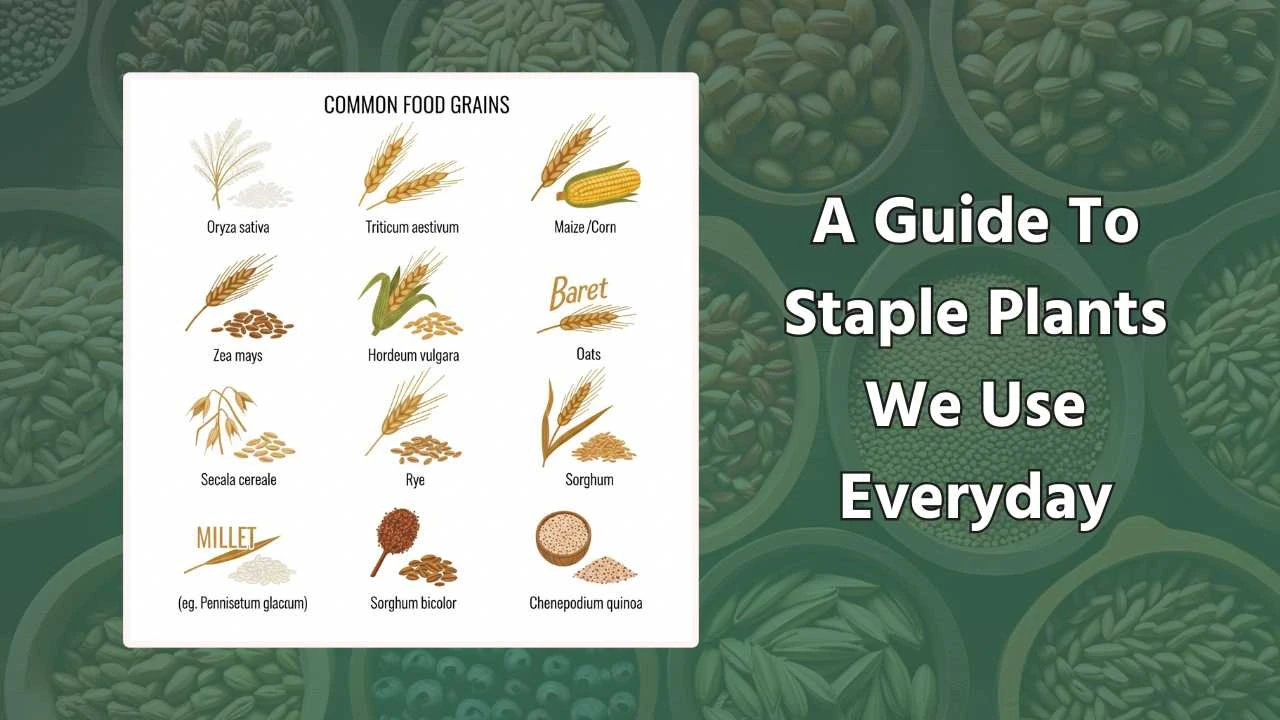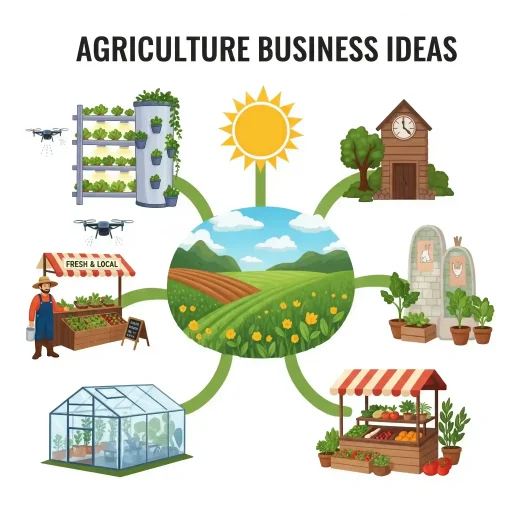What are food grains?
These grains are the seeds of plants we eat. The world consumes these grains. These grains are rich in energy and nutrients. They are also very important to our health. They are used to make porridge, rice, chapatis, breads, and other meals.
Cereals are also known as grains. Farmers grow them in large fields. They are easily cooked and can be stored. Some grains, like rice and wheat, are consumed daily. Some grains, like barley and millet, are consumed less frequently but are still very healthy.
This article will teach you the names of various food grains, what they are used for, and why it is important. We will also examine how they are grown, and how you can include them in your meal.
The Main Types Of Food Grains
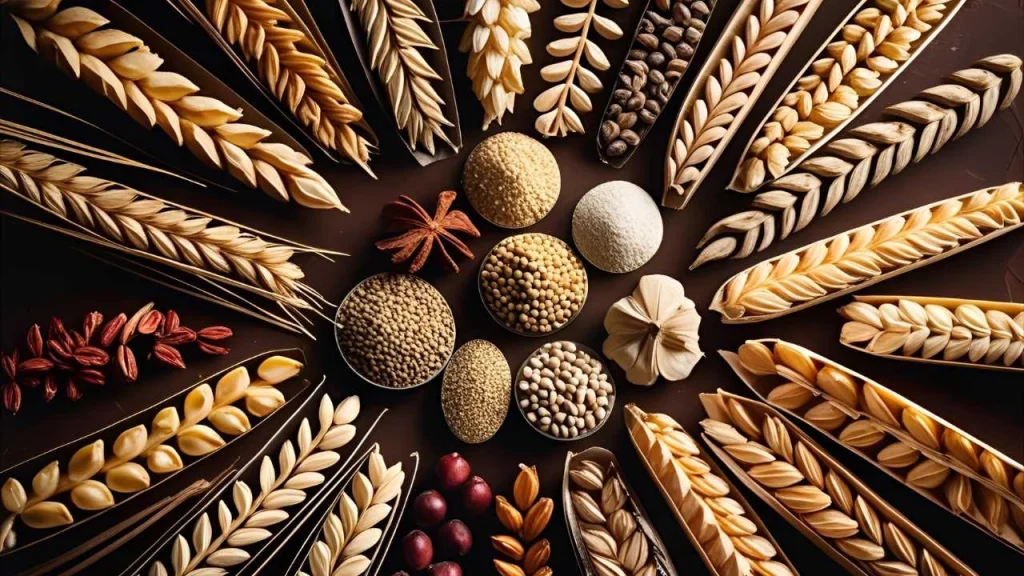
Food grains come in many different types. The most common ones are:
Rice (Oryza Sativa)
One of the most common grains around the globe is rice. It is a staple in Asia.
- Color: white, brown, black, or red
- Uses: Cooked rice, biryani, idli, dosa, rice pudding
- Health Tip Brown Rice is healthier than White Rice
Wheat (Triticum Aestivum)
Flour is made from wheat. Wheat is used in the production of bread and chapatis.
- Color: Golden brown
- Uses: Roti, paratha, bread, pasta, biscuits
- Health Tip Whole Wheat is better than refined (maida).
Maize / Corn (Zea mays)
The yellow grain is eaten either roasted or boiled. Many packaged foods also contain it.
- Color: White, yellow, purple
- Uses : Cornflakes, cornflour, popcorn, and corn flour
- Health tip: Good source of antioxidants and fiber
Want To Know About Which Business Idea Would Be Better For You?
Go Through Our Startup Selector Tool
Barley (Hordeum vulgare)
Barley is a grain that has been used for centuries to make porridge, drinks and other foods.
- Color: Dark brown
- Uses : Barley Water, soups and bread
- Health Tip: Good for digestion and heart health
Millet (Bajra Ragi Jowar)
Millets is a small grain that is very nutritious.
- Types: Bajra (Pearl millet), Ragi (Finger millet), Jowar (Sorghum)
- Uses: Millet roti, porridge, snacks
- Health Tip Rich with iron, calcium and fiber
Oats (Avena sativa)
Breakfast foods often include oats.
- Color: Pale cream
- Uses: Oatmeal, cookies, cereal
- Health Tip Helps Control Blood Sugar and Weight
Rye (Secale cereale)
Rye is used to make breads and cereals.
- Color: Greyish-brown
- Uses : Rye Bread, Crispbread
- Health Tip Lower gluten than wheat
Read Our More Articles On Food Industry: Click Here
Other Important Grains
Quinoa (Chenopodium quinoa)
First up, let’s talk about quinoa. Now, even though it’s not technically a cereal, let’s be real—most folks treat it like a grain anyway. You’ll spot it in black, white, or red, so take your pick. People love tossing quinoa into cooked dishes or mixing it into salads. And here’s the real flex: it’s got all those amino acids, so you’re getting a complete protein every time you dig in.
Amaranth
Next on the list is amaranth. If you’ve ever been in India during fasting season, you’ve probably bumped into this one. It shows up as a light yellow seed and gets turned into all sorts of things, like rajgira laddoos or even flour. The best part? Amaranth is loaded with protein and iron, making it a solid choice if you’re trying to eat healthy food.
Buckwheat (Kuttu)
Finally, let’s not forget buckwheat, or kuttu as it’s called in India. This grain steals the spotlight during fasting too. With its dark brown color, it adds some drama to your plate. Most people use it to make kuttu rotis or pakoras—basically, comfort food at its finest. Plus, it’s gluten-free and good for your heart, so you can munch away without stressing.
Read Our Book On Cereals And Cereal Products Processing Industry
Importance of Food Grains
The importance of food grains to our bodies and society cannot be overstated.
Energy Source
Our body requires carbohydrates for energy.
Easy to Store
These products do not go bad quickly, and they can be stored in shops and homes.
Buy Tickets Online
These foods are more affordable and also fill you up.
Nutritious
Whole grains are rich in fiber, proteins, vitamins and minerals.
Farmer’s Day
They are an important part of farming and a source of income for farmers.
Read More: Build a Sustainable Business: Women-Led Food Processing Startups & Success Stories
How Food Grains Are Grown
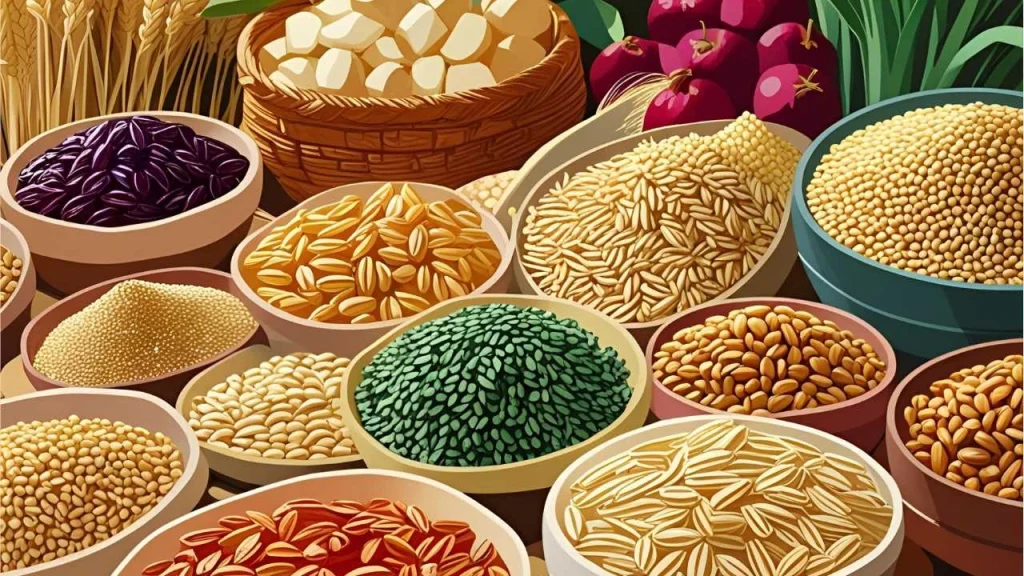
Farmers grow grains in fields. Here’s the general process.
- First, farmers toss those seeds into the soil—sometimes by hand, sometimes with machines, depending on the mood (or budget).
- Next up, the fields need water. Maybe it rains (fingers crossed), or maybe they’ve got to fire up the irrigation system.
- After that, the waiting begins. Depending on the type of grain, the plants take anywhere from two to six months to grow—patience is key here.
- Eventually, when the crops are finally ready, it’s time to harvest. Cue the big machines and a whole lot of sweat.
- Finally, the grains get cleaned, dried, and safely stored so they stay fresh for whenever people are ready to chow down.
- And there you have it—grain growing, with a little extra flair.
The best seasons to grow different grains are:
- Kharif grains (monsoon seasons)
- Rabi grains: Barley, wheat (winter season).
- Zaid crops: Crops grown between Kharif & Rabi
Whole Grains vs Refined Grains
| Features | Whole Grains | Refined Grains |
|---|---|---|
| Fiber | Yes, | No, |
| Processors | Reduced processing | Heavily processed |
| Nutrients | You can find out more about us by clicking here. | Fewer |
| Example | Brown rice and whole wheat | White rice, maida |
| Health Impact | You can also read: | May cause weight gain |
Read Our Food Processing and Agriculture Based Project Report
Healthy Ways to Eat Grains
- Rotis made from multigrain wheat flour
- Replace white rice by brown or millets
- Use oatmeal for breakfast
- Mixing different grains to improve taste and health
- Don’t eat too many fried or sugar-covered grains
Conclusion: Grains Are Nature’s Gift
To start with, can you even picture a meal without grains? Seriously, they’re everywhere. Besides, rice, oats, ragi, corn—all of them pull their own weight. Not only do they pack in the nutrients, but honestly, they’re the main reason you’ve got the energy to get through your day. Plus, every grain’s got its own personality. For instance, rice is the reliable classic, while ragi’s the go-to if you’re trying to be all healthy. Then there’s oats, which basically own the breakfast scene, and maize—come on, who doesn’t get excited about corn on the cob?
So, add more whole grains to the plate for a healthy lifestyle!
FAQs About Food Grains Names
Q1. What is food grain?
We eat seeds such as rice, wheat and maize.
Q2. What are the healthiest grains to eat?
Some of the most nutritious grains are millets, oats and whole wheat.
Q3. Are all grains gluten-free?
No. Wheat, rye and barley has Gluten. Gluten-free grains include rice, millets, corn and millets.
Q4. How can I store grains at home?
Keep them away from moisture in airtight, dry containers.
Q5. Are grains good for weight loss?
Whole grains rich in fiber can help you lose weight.
Q6. What is the difference in a grain and a pulse?
Grains include cereals such as rice and wheat. Pulses include lentils and beans such as moong and Chana.
Q7. Can I eat grains everyday?
They are an essential part of any healthy diet.

